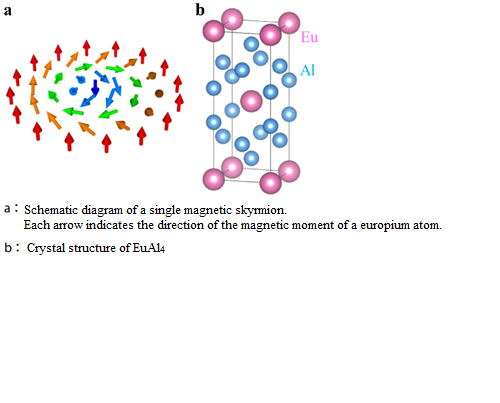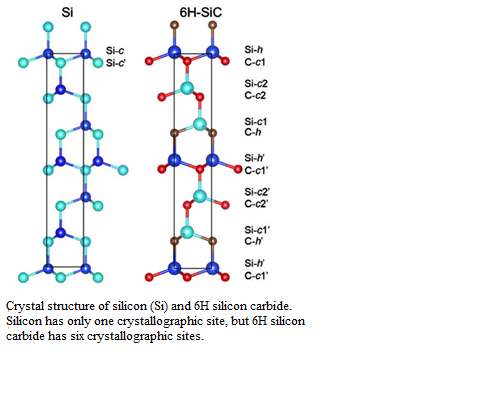J-PARC News May 2022 (Issue#205)
■ Discovery of a Simple Binary Alloy Material Exhibiting Ultra-High-Density Magnetic Vortices
—Applications Expected in Next-Generation Magnetic Memory— (March 30)
The swirling structures of the magnetic moments of electron spins known as magnetic skyrmions (magnetic vortices) are garnering attention as candidate information carriers for power-saving, high-density, next-generation magnetic memories. Previously, magnetic skyrmions were thought to occur only in materials with a special, noncentrosymmetric crystal structure, but in recent years, it has been reported that ultra-high-density magnetic skyrmions occur even in completely ordinary crystal structures.
A research group led by Assistant Professor Rina TAKAGI and Associate Professor Shinichiro SEKI of the School of Engineering, The University of Tokyo, working jointly with RIKEN, Institute for Solid State Physics of the University of Tokyo, JAEA, Comprehensive Research Organization for Science and Society (CROSS), and Graduate School of Frontier Sciences of the University of Tokyo, carried out neutron and X-ray scattering experiments in EuAl4 (Eu: Europium, Al: Aluminum), which has a centrosymmetric crystal structure, and discovered that ultra-high-density magnetic skyrmions are produced with a diameter of 3.5 nanometers. Moreover, they found that the skyrmion lattice was changed from square to rhombic by changing the magnetic field and temperature. Those changes derive from interaction mediated by the itinerant electrons which move around the material.
Formation of magnetic skyrmions was demonstrated even in the simple alloy composed of two elements, and thus it is likely that simpler information media can be achieved. A further search for materials that exhibit ultra-high-density magnetic skyrmions, whose arrangements have a high degree of freedom as in the case of this discovery, are expected to open up a path to next-generation magnetic memory materials.
For details, please see the J-PARC website.
https://j-parc.jp/c/press-release/2022/03/30000875.html
■An Unusual Structure Formed by Boron in a Power Device Semiconductor
—The Science of 3D Local Structure Opened Up by Neutron Holography— (April 4)
Silicon remains the mainstream semiconductor material today, but to meet demand for higher power, higher communication speed, and other improvements, there is an urgent need to develop power devices capable of efficient control and conversion of power with minimal loss. A promising candidate material is silicon carbide (SiC) crystal. Tiny amounts of impurities such as boron must be added in order for semiconductors to function. In silicon crystal, boron has been known to occupy a single position (crystallographic site), but in SiC it can occupy six different positions due to the complex structure. Properties as a semiconductor vary depending on where the impurities locate, and thus it is essential to control the crystallographic sites. However, thus far, there has been no method to determine the crystallographic sites boron occupies.
Professor Koichi HAYASHI of the Nagoya Institute of Technology, Professor Kenji OHOYAMA of the Ibaraki University, Associate Professor Naohisa HAPPO of the Hiroshima City University, and their colleagues have successfully achieved precise atomic imaging around boron, the dopant in SiC, by using “multiple-wavelength neutron holography” a world-leading technique developed and established through a joint effort with the JAEA. As a result, it was found that boron preferentially occupies only two of the six crystallographic sites, and hardly occupies the other sites. This is thought to be because the boron atoms exert some effect which induces a discontinuous boundary nearby. Since it may also be attributable to the fabrication method, these results are expected to be useful for developing SiC wafers in the future.
For details, please see the J-PARC website.
https://j-parc.jp/c/press-release/2022/04/04000877.html
■Why is the 24-Hour Rhythm of Living Organisms Stable?
—Temperature Compensation Control of Clock Proteins Examined Based on the Motion of Hydrogen Atoms— (April 13)
Life adapts to the environmental changes of the 24-hour cycle due to the earth's rotation, regardless of temperature variation due to the seasons and the heat/cold cycles of day and night. What supports this rhythm is a “circadian clock” system called a biological clock. This is a biological phenomenon shared by a wide range of species including bacteria, plants, insects, and mammals. It has a property called “temperature compensation” whereby it marks off a rhythm with a 24-hour cycle, regardless of temperature variation. In particular, it is known that the circadian clock of cyanobacteria has the advantage of allowing research in a test tube, and reconstitution is possible by mixing together three types of clock proteins (KaiA, KaiB, KaiC) and adenosine triphosphate (ATP) in a test tube.
Assistant Professors Yoshihiko FURUIKE and Atsushi MUKAIYAMA, Professor Shuji AKIYAMA, Post-Doctoral Fellow Dongyan OUYANG, and others at the Institute for Molecular Science of the National Institutes of Natural Sciences, working jointly with the National Institutes for Quantum Science and Technology, the Comprehensive Research Organization for Science and Society (CROSS), and the JAEA, have designed KaiC mutants which have lost their temperature compensation ability, and this is useful for comparison with temperature-compensated wild KaiC. KaiC mutants include those where the rhythm accelerates due to rising temperature, and those where, conversely, the rhythm decelerates at higher temperatures. These KaiC mutants were brought to the BL02 DNA spectrometer of MLF and the researchers observed the motion of hydrogen atoms scattered throughout the protein molecules in quasi-elastic neutron scattering experiments. The results showed that the motion of atoms inside KaiC was accelerated due to rising temperature, just like general proteins. This result was the same not just for temperature-compensated wild KaiC, but also for accelerated and decelerated KaiC mutants. On the other hand, all KaiC mutants with higher temperature sensitivity were confirmed to exhibit a conspicuous slowing of overall motion of molecules compared with the wild-type KaiC. These results suggest that motion spanning the entire KaiC molecule is closely connected with autonomous control to prevent acceleration/deceleration due to temperature and maintain a constant reaction.
Different species have different types of clock proteins. Nevertheless, their robustness to temperature means they share some characteristics different from general proteins. By broadening observations to clock proteins of other species, we may close in on the secrets of autonomous control mechanisms which underpin temperature compensation of circadian clocks.
For details, please see the J-PARC website.
https://j-parc.jp/c/press-release/2022/04/13000880.html
■J-PARC Hello Science “Exploring the Mysteries of the Universe and Matter with the High Intensity Proton Accelerator Facility at J-PARC” (April 22)
At our first Hello Science event of this fiscal year, the Director of the J-PARC Center, Takashi KOBAYASHI, presented the overview, science, and the future prospects at J-PARC. This talk was live-streamed via the YouTube KEK channel as part of events for the Science and Technology Week.
The talk began by pointing out that J-PARC can be used as an “ultra-microscope” for looking at extremely tiny things, an “ultra-telescope” for looking deep into space, and a “time machine” for looking back at the origin of the universe. Next, he explained the principles of accelerators, pointing out the intensity of the proton beams produced at J-PARC, and the distinguishing features of the three accelerators which produce those beams. He also discussed use of neutron and muon beamlines for investigating conjectures on proteins and the high-pressure conditions in the earth's core, and helping to improve the performance of tires and lithium batteries. As recent topics, he presented examples of non-destructive analysis of the “sealed medicine bottle” of OGATA Koan, and rock material from the asteroid Ryugu brought back by Hayabusa2. Next, he touched on the outlook in areas such as the research on the interior matter in neutron stars (thought to be the densest objects in the universe) by reproducing postulated environment inside them. He also discussed elucidating the properties of neutrinos and anti-neutrinos, and differences in the properties of matter and anti-matter, in order to investigate the origins of matter in the universe. Finally, he mentioned facility open houses, Hello Science, and other events which aim to broaden knowledge of J-PARC among the public.
Videos of Hello Science events are available at J-PARC's website.
http://j-parc.jp/c/public-relations/movies.html#Hello-science
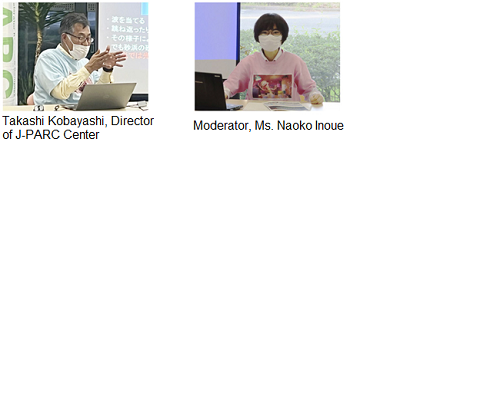 ■Sanpo-michi #23: —A Promise to the Birds—
■Sanpo-michi #23: —A Promise to the Birds—
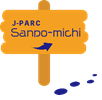
J-PARC has authentic birdbaths. The huge stones weighing close to 10 tons, with their top side hollowed out, are placed at two locations on a 700-m2 site, and water flows in them. Water has been continuously offered for the birds since the baths at J-PARC were completed in 2006. Birds in Tokai Village probably know that they can drink water here. There may even be migratory birds which travel thousands of kilometers to drink water here.
Many birds immediately fly away when they sense people coming close, so we almost never see each other face to face. However, the birds show us a wide alley of behaviors in the video below taken without us. We can see a warbling white-eye and a Japanese tit staying together and bathing while splashing each other. The baths will be used like this by generations of various birds. The birdbaths at J-PARC are important places for nurturing the ecosystem. We support it through some activities like keeping the water clear. Recently foliage turns deeper green and small insects move more actively. The birdbaths at J-PARC will be not only places to drink water but also restaurants for them from now on.
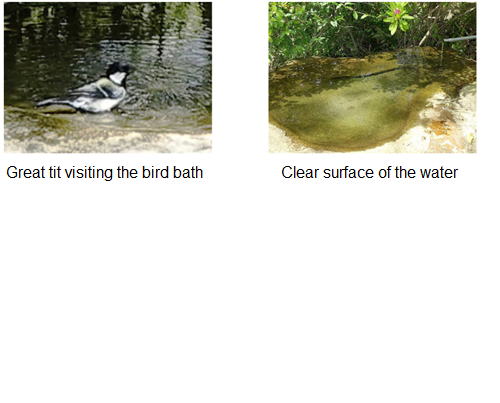 Click here to view a GIF video of a warbling white-eye and Japanese tit having a friendly bath together.
Click here to view a GIF video of a warbling white-eye and Japanese tit having a friendly bath together.

